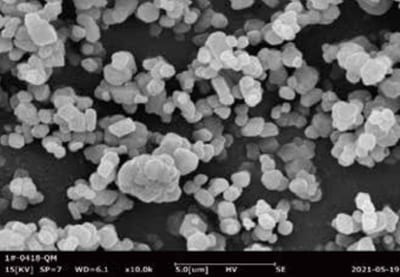Aluminum Nitride (AlN) powder is widely used in industries that demand high thermal conductivity, electrical insulation, and mechanical strength. It is crucial in electronic packaging, thermal interface materials, high-power semiconductor devices, and aerospace applications. In many of these fields, AlN powder requires surface modification to meet specific performance requirements.
Why Modify Aluminum Nitride Powder?
Aluminum nitride is highly reactive and easily absorbs moisture, leading to hydrolysis. Initially, aluminum nitride forms an amorphous AlOOH phase, which, under certain temperature, pH, and ionic activity conditions, can further transform into Al(OH)3. This reaction results in the formation of a layer of aluminum hydroxide or a thin layer of aluminum hydroxide on the surface, which increases the oxygen content in the material. In aluminum nitride ceramics, this directly reduces thermal conductivity. After surface modification, aluminum nitride powder improves compatibility with different matrix materials, enhances dispersion, and prevents hydrolysis in moisture-sensitive environments. Below, we will explore several common surface modification methods for aluminum nitride powder and their advantages.
1. Inorganic Hydrolysis-Resistant Modification
To address AlN's moisture sensitivity, inorganic hydrolysis-resistant modification provides an effective solution. This method coats AlN powder with an inorganic protective layer, preventing hydrolysis and oxidation. By forming a stable barrier, it enhances environmental resistance while maintaining high thermal conductivity.
AIN PH testing in an 80°C water bath

WR Hydrolysis Resistance Test Report
Product Name | Aluminum Nitride Filler Powder WR Type | |||||||
Equipment and Materials | Thermostatic water bath, beaker, pure water, wide-range pH test paper | |||||||
Test Procedure | 1. Set water bath to 80°C. 2. Weigh 10g sample into 250ml beaker, add pure water to 100ml mark. 3. Place beaker in water bath, monitor pH changes (add pure water as needed). | |||||||
Test Results (L/LG Grade) | 7 days | 14 days | 30 days | |||||
pH = 7 | pH ≤ 7.5 | pH ≤ 8.5 | ||||||
Test Results (G Grade) | 7 days | 14 days | 30 days | |||||
pH = 7 | pH ≤ 7 | pH ≤ 7.5 | ||||||
Remarks | Ordinary AlN powder: pH >10 in 15 mins, ammonia odor, clumping. WR-coated powder: pH < 8.5 after 30 days, no ammonia odor, no clumping. | |||||||
Advantages of Inorganic Hydrolysis-Resistant Modification
✔ Enhanced Stability – Prevents hydrolysis and oxidation, improving material durability.
✔ Improved Thermal Conductivity – Reduces oxygen content to maintain high thermal performance.
✔ Better Storage & Handling – Minimizes moisture sensitivity for easier transportation.
✔ Application Versatility – Ideal for polymer-based composites, thermal interface materials, and electronic packaging.
✔ Consistent Performance – Ensures reliable properties across various processing conditions.
Heeger Materials offers high-quality Aluminum Nitride Powder with inorganic hydrolysis-resistant modification, ensuring superior stability and performance for advanced applications.

2. Coupling Agent Modification
Coupling agents improve AlN's affinity with polymer materials by bonding to both the powder surface and the surrounding matrix. This enhances dispersion and compatibility in composite applications.
Common Types of Coupling Agents
- Silane Coupling Agents – The most widely used, with a general structure of Y-(CH2CH2-Si)-X3, where: Y = organic functional group (vinyl, methacryloyl, epoxy, amino, thiol). X = characteristic group that classifies silanes (hydrolyzable silanes, peroxide silanes, polysulfide silanes).
- Titanate Coupling Agents – Developed by Kenrich Petrochemicals in the 1970s, effective for modifying various inorganic particles.
- Aluminate Coupling Agents – A newer class offering enhanced performance for AlN surface treatment.
3. Combination of Inorganic Hydrolysis Resistance and Silane Coupling Modification
For applications requiring both moisture resistance and improved polymer compatibility, a dual-modification approach is used. This combines the benefits of silane coupling agents with hydrolysis-resistant coatings, ensuring long-term stability and enhanced integration into various composite systems.

AlN Powder Modification Affecting Factors
Several factors influence the effectiveness of AlN surface modification, including temperature, duration, and the amount of modifying agent used. Surface modifiers interact with functional groups on the powder, and their chemical structure, molecular chain length, and molecular weight directly impact dispersion in polymer matrices.
- Low molecular weight modifiers create a thinner coating, potentially leading to poor dispersion.
- High molecular weight modifiers form a thicker coating, improving compatibility with organic matrices.
- Solvent selection also plays a role. When using silane coupling agents, a small amount of anhydrous ethanol or other solvents is often added to accelerate the reaction. However, improper solvent use may alter the interaction between AlN and the coupling agent.
Choosing the Right Modification Method
Each modification method offers distinct advantages, and the best choice depends on your specific application needs:
- For improved resin compatibility → Silane coupling modification.
- For moisture-sensitive environments → Hydrolysis-resistant modification.
- For maximum stability and versatility → Combined treatment.
Conclusion
Surface modification plays a critical role in optimizing the performance and usability of aluminum nitride powder across various industries. By selecting the appropriate treatment, manufacturers can enhance durability, processability, and thermal performance.
Heeger Materials provides a range of AlN powders, including Aluminum Nitride (AlN) Surface Modification Powder, Aluminum Nitride (AlN) Granulation Powder, and Spherical Aluminum Nitride (AlN) Powder, ensuring tailored solutions for diverse applications.



